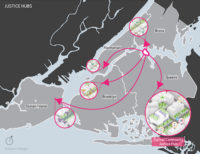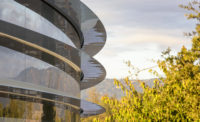
Photo © George Hirose at the Japan Society
Tadao Ando knows a thing or two about entertaining a crowd. Between candid anecdotes about his celebrity clients (he once hung up on Georgio Armani), workout routine (8 p.m. every evening), and a smattering of life lessons, the 72-year-old Japanese architect spoke openly about the art world’s influence on his career during a lecture at the Japan Society in New York City.

Photo © George Hirose at the Japan Society
“We are losing sight on art,” Ando said through an interpreter Thursday, just days before the opening of his expansion for the Clark Art Institute in Williamstown, Massachusetts. “Looking at art and being moved by art empowers us.”
Husky-voiced and sporting his signature bowl-cut hairstyle, Ando spoke about his upbringing in downtown Osaka, which he called a “no mans land.” Ando said he was inspired to become an architect because of his love for mathematics, and observations of construction workers as they renovated his childhood home.
Short on cash and good grades, Ando earned his keep fighting in the boxing ring, and studied architecture on his own. “Of course the neighbors just laughed at me,” Ando said. Years later, fellow Pritzker Prize laureate Renzo Piano would ask Ando what the connection between architecture and boxing is. “Nobody helps you in the ring,” Ando told him.
As Ando reached his late teens, he said was exposed to the work of the radical Gutai Group, an influential art collective founded in his home city. Increasingly, he found inspiration in the work of artists including action painters Kazuo Shiraga, known for smearing paint with his feet, and Jackson Pollock. He admired how these artists painted outside the lines, literally and figuratively. Of Pollock, Ando said, “Looking at him, I thought I had the freedom to go beyond as well.
Ando flicked through slides of his museum projects—the Museum of Picture Books, the Chichu Art Museum on Naoshima, The Pulitzer Foundation for the Arts, and renderings for the new Clark expansion.
Today, Ando rubs shoulders with Bono (The U2 singer broke into a rendition of Amazing Grace while touring Church of the Light with Ando), photographer Hiroshi Sugimoto (who was present at the lecture in the front row), and James Turrell.
He especially venerates artists who are productive well into old age and presented the work of Yayoi Kusama and photographer David Douglas Duncan. Ando showed an image of an elderly Pablo Picasso, photographed by Duncan, at work and shirtless; he spoke admiringly of the artist’s strong-looking back. “We have to keep intentionally seeking youth,” Ando said.
Youthfulness is an attribute Ando certainly does not lack. At the conclusion of the address, the architect jogged off the stage, arms raised like a rock star, to greet his adoring fans upstairs.
So to Ando, what is the difference between art and architecture? “I feel they are in conflict,” he said in an interview while signing autographs at the pace of a laser printer. “Their objectives are different: artists put their life in the work, while architects design their buildings to receive it."


